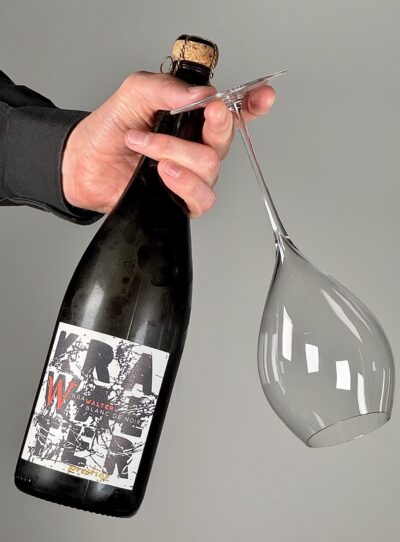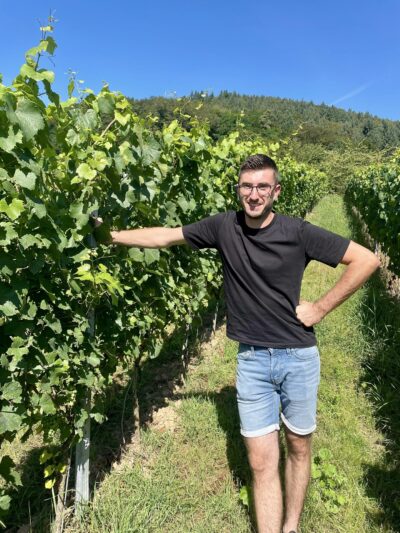Krawalter Blanc de Noir 2021 Prestige – pure, precise, uncompromising
 Sometimes it doesn’t take a revolution to start something new – just the courage to do things differently.
With Krawalter, Felix Walter has created his own signature within his family’s estate, Weingut Josef Walter in Bürgstadt: wines that show structure and character rather than volume. Spontaneously fermented, unfiltered, and crafted with uncompromising precision – the expression of a clear idea of origin and authenticity.
Sometimes it doesn’t take a revolution to start something new – just the courage to do things differently.
With Krawalter, Felix Walter has created his own signature within his family’s estate, Weingut Josef Walter in Bürgstadt: wines that show structure and character rather than volume. Spontaneously fermented, unfiltered, and crafted with uncompromising precision – the expression of a clear idea of origin and authenticity.
Shaped by formative stints at Huber in Malterdingen, in Burgundy, and in New Zealand, Walter now works with minimal intervention and maximum attention to detail. The fruit comes from organically farmed parcels in Erste Lagen around Bürgstadt, where the lean Buntsandstein (coloured sandstone) lends both structure and tension – in still and sparkling wines alike.
The move towards sparkling wine was therefore no whim, but a logical consequence. The Blanc de Noir Brut Nature Prestige 2021, pressed on a historic basket press and matured for 34 months on the lees, perfectly encapsulates Walter’s philosophy: pure, precise and without cosmetic dosage – a wine that doesn’t seek to please, but to convince.
Interview with Felix Walter – Krawalter
 1. What distinguishes the wines of Krawalter from those of Weingut Josef Walter – and what connects them? How do your approaches differ when it comes to sparkling wine production?
1. What distinguishes the wines of Krawalter from those of Weingut Josef Walter – and what connects them? How do your approaches differ when it comes to sparkling wine production?
What connects the wines is meticulous vineyard work. Only grapes from our own vineyards are used, all farmed according to organic principles – with low yields, extensive manual work and our own composting, to name just a few aspects. The fruit for the Krawalter range comes entirely from Erste Lagen, while that for the estate wines also includes grapes from the Große Lagen Centgrafenberg and Hundsrück. In the future, I might even revive old vineyard names such as Im Stübchen or Hohenlinde.
After hand-harvesting into small crates, the cellar work for both lines differs significantly. For the sparkling wines, the grapes are pressed whole – the “regular” cuvée with a pneumatic press, the Prestige with the historic basket press – and the juice is left untouched for eleven months until tirage. The must goes cloudy into used oak barrels, where it undergoes spontaneous fermentation and malolactic conversion. Barrels are topped up weekly. Shortly before the next harvest, the previous vintage is bottled for secondary fermentation with yeast and sugar. The 2021 Prestige was disgorged after 34 months on the lees, without dosage or sulphur addition.
For the reds, I use full-cluster fermentation with no sulphur on the must; at the estate, most lots are destemmed and receive a light sulphur addition. The main difference in the whites is that my wines ferment spontaneously for twelve months in used oak of various sizes and go through malolactic conversion. I completely avoid chaptalisation and the use of sulphur. After twelve months, they spend a further six to eight months on full lees in stainless steel.
2. What makes the terroir of the Bürgstadter Centgrafenberg so exciting for sparkling wine?
The Bürgstadter hill has a long tradition of Pinot Noir. Even today, every second vine in Bürgstadt is Pinot Noir – in our estate it’s 70 percent. I was intrigued to see how the austere Buntsandstein soil would express itself in a sparkling wine. I find parallels to our red Burgundies: in the finish, for instance, I often detect a graphite note, unmistakably linked to the sandstone. From Buntsandstein you can produce truly distinctive, high-quality sparkling wines. I’m curious to see how the coming vintages will evolve.
3. What was the initial spark behind Krawalter – and where do you see the project heading?
The idea was never to create another wine label within our family estate. I wanted to work with my parents to push quality further and lift the winery into Germany’s top tier. During my apprenticeship at Weingut Huber in Malterdingen, I began experimenting with tiny quantities for sparkling wine. What I tasted there blew me away – Selosse, Moussé, Prévost, Laval – proper Champagne.
At the same time, I followed the rise of German producers like Griesel, Burkhard Schür and Krack – who are now friends. There was a momentum that I wanted to be part of. Later, my path led me to Burgundy and Domaine Chantereves. I spent six months there, and what I learned and tasted was simply inspiring: such purity, restraint, and tension – I wanted to craft Chardonnays in that spirit.
It fitted perfectly that we had planted Chardonnay in the Im Stübchen parcel in 2018, and the vines were just coming into production. My father gave me full creative freedom, and with the 2022 vintage, things really took off. A year and a half later, when I bottled the wine (2023 was already in barrel by then), I realised how much it resonated with me – though I suspected our private clients might find it a little surprising. That’s when I knew: with Krawalter, I could make my own statement. The same applied to the whole-cluster Pinot Noir – and the sparkling wines, whose marketing I hadn’t even planned yet.
The nickname Krawalter actually originated during my time at technical school, where I stood out for my “unconventional” taste and for many debates with teachers – especially about organics and red-wine vinification. During one of these discussions, a classmate exclaimed: “Krawalter, be quiet!” From that day on, the name stuck – and I knew there couldn’t be a better one for my wines.
Where the project is heading remains open. What I can say is that production will gradually increase, and from the 2024 vintage onwards, Sylvaner will join the range.
4. What do you value most when crafting your wines?
For all my wines, I aim to intervene as little as possible – always with the goal of expressing the origin as purely as possible in the glass.
Tasting Note: Krawalter Blanc de Noir Brut Nature Prestige 2021
Tasted from a Lehmann Glass GD Champagne (Handmade) at around 10 °C, freshly opened.
Even as it’s poured, the golden-hued wine releases intense aromas of red and yellow apple, perceptible without even lifting the glass – a promising start, with striking aromatic intensity. On closer inspection, notes of quince, raspberry, red cherry, wet stone, brioche, cheese rind, caramel and a subtle smokiness emerge.
On the palate, the wine is surprisingly restrained in fruit, focusing instead on its linear yet beautifully integrated acidity and deep, saline minerality. Fruit appears only as a suggestion – flashes of quince and lemon. The extended lees ageing contributes layers of brioche, biscuit and nutty nuances, while the interplay between freshness and a touch of oxidation is perfectly judged.
The mousse is fine and elegant, lending lightness without sacrificing depth. The mouthfeel is tense yet refined, the body medium but substantial. The finish is long, complex and quietly persistent.
The drinkability is exceptional; the quality, outstanding. The bottle was simply too small – or the thirst too great.
With a production of only 300 bottles, priced at €44 (as of October 2024, available through Vinisüd), this is a rare and compelling expression of German sparkling wine craftsmanship.
My sincere thanks go to Felix Walter for taking the time to answer my questions. The last photo was provided to me by Felix Walter and is published here with his kind permission.
